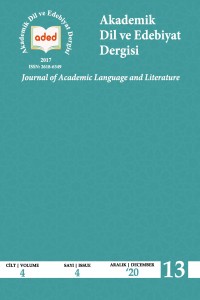Abstract
Keywords
Old Anatolian Turkish syntax (syntactic structure) simple sentences sequential sentences compound sentences
References
- ATABAY, Neşe, ÖZEL, Sevgi, ÇAM, Ayfer, Türkiye Türkçesinin Sözdizimi, Türk Dil Kurumu Yayınları, Ankara 1981.
- BANGUOĞLU, Tahsin (1986). Türkçenin Grameri, Türk Dil Kurumu Yayınları, Ankara.
- CLAUSON, S. Gerhard. (1972). An Etymological Dictinary of Pre-Thirteenth-Century Turkish, Oxford.
- DELİCE, H. İbrahim (2003). Türkçe Söz Dizimi, Kitabevi Yayınları, İstanbul.
- DEMİRCİ, Muhsin (2001). Tefsir Usulü ve Tarihi, Marmara Üniversitesi İlahiyat Fakültesi Vakfı Yayınları, İstanbul.
- DENY, Jean. (2012). Türk Dili Grameri (Osmanlı Lehçesi), (Çeviren: Elöve, A. U.), İstanbul: Kabalcı Yayınevi. [yeniden dizilmiş baskı].
- Derleme Sözlüğü (1963-1982). Ankara: Türk Dil Kurumu Yayınları.
- DOĞAN, Enfel (2006), “Ahlâk-I Alâî'deki Çün'lü Birleşik Cümle Yapıları”, Türk Dili Araştırmaları Yıllığı – Belleten, S. 54/2 29-40.
- DOĞAN, Enfel (2006). Ahlâk-ı Alâî (Metin-Sözlük-Sentaks İncelemesi), Basılmamış Doktora Tezi, İstanbul Üniversitesi Sosyal Bilimler Enstitüsü, İstanbul.
- HAMİDULLAH, Muhammed (1964). "Kuran-ı Kerim'in Türkçe Tercümeleri", Türkiyat Mecmuası, İstanbul.
- JOHNSON, Francis. (1852). Dictionary Persian, Arabic and English, London: W. H. Allen and Co.
- JUNKER, H. & BOZORG A. (1965). Persisch-Deutcsches Wörterbuch, Tehran: Kamangır Publications. KARAAĞAÇ, Günay (2009). Türkçenin Söz Dizimi, İstanbul , Kesit Yayınları.
- MENINSKI, F. (2000). Thesaurus Linguarum Orientalium, Turcicae, Arabicae, Persicae, I-VI, (Yayımlayan: Ölmez, M.), İstanbul: Simurg Yayınları. (İlk yayım DC. LXXX:1680)
- Misalli Büyük Türkçe Sözlük (2005). Kubbealtı Yayınları, İstanbul. ÖZKAN, Mustafa, “Eski Anadolu Türkçesi Döneminde Ortaya Konan Kuran Tercümeleri Üzerine-I”, Türk Dili ve Edebiyatı Dergisi, C.XXXIX, 2010, s.115-159.
- ÖZKAN, Mustafa, SEVİNÇLİ, Veysi (2009). Türkiye Türkçesi Söz Dizimi (Kelime Çözümlemeli), İstanbul.
- REDHOUSE, J. W. (1890). Redhouse English-Turkish Dictionary, İstanbul.
- STEINGASS, F. J. (1892), Comprehensive Persian-English Dictionary.
- ŞAN, Funda (2011). Üveys b. Hoca Osmân b. Emîr İlyâs b. Evliyâ’nın ‘Amme Cüzü Tefsiri Üzerinde Dil İncelemesi, İstanbul Üniversitesi, Sosyal Bilimler Enstitüsü, Basılmamış yüksek lisans tezi, İstanbul.
- ŞAN, Funda (2012). “Üveys bin Hoca Osman bin Evliya'nın Amme Cüzü Tefsiri”, Journal of Turkish Studies (JTS), 38, Boston-Istanbul, s.115-124.
- Tarama Sözlüğü, (1963-1977) .I-VIII, Ankara: Türk Dil Kurumu Yayınları.
- TİKEN, Kamil (2004). Eski Türkiye Türkçesinde Edatlar, Bağlaçlar, Ünlemler ve Zarf Fiiller, Türk Dil Kurumu Yayınları, Ankara.
- Türkiye Diyanet Vakfı (2005). Kur’an-ı Kerim ve Açıklamalı Meali, Ankara.
- YILDIRIM, Kübra (2011). Üveys bin Hoca Osmân bin Emîr İlyâs bin Evliyâ’nın Amme Cüzü tefsiri üzerine dil incelemesi (Vr. 202b-268b), İstanbul Üniversitesi, Sosyal Bilimler Enstitüsü, Yayınlanmamış yüksek lisans tezi, İstanbul.
- YILDIRIM, Kübra (2012). “Eski Anadolu Türkçesine Ait Bir Tefsirin Üslûp Özellikleri”, Turkish Studies -Volume 7/2, p.1217-1227, Ankara.
- ZENKER, J. T. (1866-1867). Türkisch-arabisch-persisches Handwörterbuch, Leipzig: Strauss&Cramer GmbH.
Abstract
Keywords
Eski Anadolu Türkçesi söz dizimi (sentaks) basit cümleler sıralı cümleler birleşik cümleler
References
- ATABAY, Neşe, ÖZEL, Sevgi, ÇAM, Ayfer, Türkiye Türkçesinin Sözdizimi, Türk Dil Kurumu Yayınları, Ankara 1981.
- BANGUOĞLU, Tahsin (1986). Türkçenin Grameri, Türk Dil Kurumu Yayınları, Ankara.
- CLAUSON, S. Gerhard. (1972). An Etymological Dictinary of Pre-Thirteenth-Century Turkish, Oxford.
- DELİCE, H. İbrahim (2003). Türkçe Söz Dizimi, Kitabevi Yayınları, İstanbul.
- DEMİRCİ, Muhsin (2001). Tefsir Usulü ve Tarihi, Marmara Üniversitesi İlahiyat Fakültesi Vakfı Yayınları, İstanbul.
- DENY, Jean. (2012). Türk Dili Grameri (Osmanlı Lehçesi), (Çeviren: Elöve, A. U.), İstanbul: Kabalcı Yayınevi. [yeniden dizilmiş baskı].
- Derleme Sözlüğü (1963-1982). Ankara: Türk Dil Kurumu Yayınları.
- DOĞAN, Enfel (2006), “Ahlâk-I Alâî'deki Çün'lü Birleşik Cümle Yapıları”, Türk Dili Araştırmaları Yıllığı – Belleten, S. 54/2 29-40.
- DOĞAN, Enfel (2006). Ahlâk-ı Alâî (Metin-Sözlük-Sentaks İncelemesi), Basılmamış Doktora Tezi, İstanbul Üniversitesi Sosyal Bilimler Enstitüsü, İstanbul.
- HAMİDULLAH, Muhammed (1964). "Kuran-ı Kerim'in Türkçe Tercümeleri", Türkiyat Mecmuası, İstanbul.
- JOHNSON, Francis. (1852). Dictionary Persian, Arabic and English, London: W. H. Allen and Co.
- JUNKER, H. & BOZORG A. (1965). Persisch-Deutcsches Wörterbuch, Tehran: Kamangır Publications. KARAAĞAÇ, Günay (2009). Türkçenin Söz Dizimi, İstanbul , Kesit Yayınları.
- MENINSKI, F. (2000). Thesaurus Linguarum Orientalium, Turcicae, Arabicae, Persicae, I-VI, (Yayımlayan: Ölmez, M.), İstanbul: Simurg Yayınları. (İlk yayım DC. LXXX:1680)
- Misalli Büyük Türkçe Sözlük (2005). Kubbealtı Yayınları, İstanbul. ÖZKAN, Mustafa, “Eski Anadolu Türkçesi Döneminde Ortaya Konan Kuran Tercümeleri Üzerine-I”, Türk Dili ve Edebiyatı Dergisi, C.XXXIX, 2010, s.115-159.
- ÖZKAN, Mustafa, SEVİNÇLİ, Veysi (2009). Türkiye Türkçesi Söz Dizimi (Kelime Çözümlemeli), İstanbul.
- REDHOUSE, J. W. (1890). Redhouse English-Turkish Dictionary, İstanbul.
- STEINGASS, F. J. (1892), Comprehensive Persian-English Dictionary.
- ŞAN, Funda (2011). Üveys b. Hoca Osmân b. Emîr İlyâs b. Evliyâ’nın ‘Amme Cüzü Tefsiri Üzerinde Dil İncelemesi, İstanbul Üniversitesi, Sosyal Bilimler Enstitüsü, Basılmamış yüksek lisans tezi, İstanbul.
- ŞAN, Funda (2012). “Üveys bin Hoca Osman bin Evliya'nın Amme Cüzü Tefsiri”, Journal of Turkish Studies (JTS), 38, Boston-Istanbul, s.115-124.
- Tarama Sözlüğü, (1963-1977) .I-VIII, Ankara: Türk Dil Kurumu Yayınları.
- TİKEN, Kamil (2004). Eski Türkiye Türkçesinde Edatlar, Bağlaçlar, Ünlemler ve Zarf Fiiller, Türk Dil Kurumu Yayınları, Ankara.
- Türkiye Diyanet Vakfı (2005). Kur’an-ı Kerim ve Açıklamalı Meali, Ankara.
- YILDIRIM, Kübra (2011). Üveys bin Hoca Osmân bin Emîr İlyâs bin Evliyâ’nın Amme Cüzü tefsiri üzerine dil incelemesi (Vr. 202b-268b), İstanbul Üniversitesi, Sosyal Bilimler Enstitüsü, Yayınlanmamış yüksek lisans tezi, İstanbul.
- YILDIRIM, Kübra (2012). “Eski Anadolu Türkçesine Ait Bir Tefsirin Üslûp Özellikleri”, Turkish Studies -Volume 7/2, p.1217-1227, Ankara.
- ZENKER, J. T. (1866-1867). Türkisch-arabisch-persisches Handwörterbuch, Leipzig: Strauss&Cramer GmbH.
Details
| Primary Language | Turkish |
|---|---|
| Subjects | Literary Studies |
| Journal Section | Articles |
| Authors | |
| Publication Date | December 30, 2020 |
| Submission Date | October 19, 2020 |
| Acceptance Date | November 16, 2020 |
| Published in Issue | Year 2020 Volume: 4 Issue: 4 |

